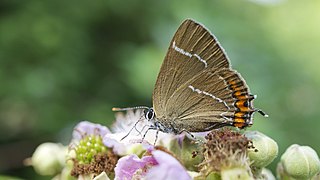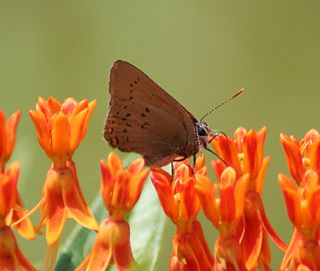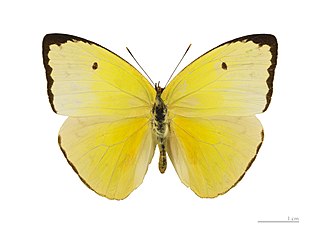
Anthocharis midea, the falcate orangetip, is a North American butterfly that was described in 1809 by Jacob Hübner. It belongs to the family Pieridae, which is the white and sulphurs. These butterflies are mostly seen in the eastern United States, and in Texas and Oklahoma. They eat the nectar of violets and mustards. They tend to live in open, wet woods along waterways, in open swamps, and less often in dry woods and ridgetops. This species is a true springtime butterfly, being on the wing from April to May.

The great purple hairstreak, also called the great blue hairstreak, is a common gossamer-winged butterfly species in parts of the United States. It is actually a Neotropical species; its North American range only includes the warm-temperate and subtropical parts of that continent, and it ranges southwards almost to the Isthmus of Panama. The type specimen, however, was shipped to Europe from the Colony of Virginia, probably around the time of the United States Declaration of Independence.

The purple hairstreak is a butterfly in the family Lycaenidae distributed throughout much of Europe, North Africa, Anatolia, Caucasia, and Transcaucasia. The larva feeds on Quercus robur, Quercus petraea, Quercus cerris and Quercus ilex.

The white-letter hairstreak is a butterfly in the family Lycaenidae.

The black hairstreak is a butterfly in the family Lycaenidae.

The gray hairstreak is also called the bean lycaenid or cotton square borer. It is a member of the Lycaenidae family, known as the gossamer-winged butterflies and the second-largest family of butterflies. It is one of the most common hairstreaks in North America, ranging over nearly the entire continent. It also occurs throughout Central America and in northern South America.

The Colorado hairstreak is a montane butterfly native to oak scrubland in the southwestern United States and northern Mexico. It was designated the state insect of Colorado in 1996. It is the only species in the genus Hypaurotis.

The Sandia hairstreak is a species of butterfly native to North America. A relatively rare butterfly with a limited range, it was discovered in La Cueva Canyon, Albuquerque, in spring of 1958, by Noel McFarland, then a student at the University of Kansas, and described the following year. The Sandia hairstreak was made one of the state insects of New Mexico in a 2002 bill approved the following year.

Satyrium titus, the coral hairstreak, is a North American butterfly in the family Lycaenidae.

Aphrissa statira, the statira sulphur, is a species of Lepidoptera in the family Pieridae. The species is a medium-sized yellow butterfly, with females more pale than males. They are found from southern regions of Florida and Texas through southern Brazil and northern Argentina. The caterpillars feed on the leaves of several local host plants, while adults prefer to feed on the nectar of red or orange colored flowers. The species is most noted for their dramatic migrations in the tropical areas of the Americas. They have been the subject of many studies about how butterflies navigate and orient during migration.

Chlorostrymon simaethis, the silver-banded hairstreak, is a North and South American butterfly in the family Lycaenidae. It is also known as St. Christopher's hairstreak and the Key lime hairstreak.

Callophrys sheridanii, the Sheridan's hairstreak and Sheridan's green hairstreak, is a butterfly in the family Lycaenidae. It is found in North America along the south coast of British Columbia and parts of Nevada, Arizona, Saskatchewan, North Dakota, and New Mexico. In 2009, this species was adopted as the U.S. state butterfly for Wyoming.

Strymon bazochii, the lantana scrub-hairstreak or smaller lantana butterfly, is a butterfly in the family Lycaenidae. It is found from Paraguay north through Central America, the West Indies and Mexico to southern Texas. It was introduced to Hawaii in 1902 to control Lantana species, in which it has proven unsuccessful.

Satyrium favonius, the oak hairstreak or southern hairstreak, is a butterfly of the family Lycaenidae. It is found in the United States from southern New England and the Atlantic Coast south to peninsular Florida and west to central Illinois, south-eastern Colorado and the Gulf Coast.

Satyrium acadica, the Acadian hairstreak, is a butterfly of the family Lycaenidae. It is found in North America from British Columbia east to Nova Scotia and south to Idaho, Colorado, the northern Midwest, Maryland, and New Jersey.

Satyrium behrii, the Behr's hairstreak, is a butterfly of the family Lycaenidae. It is found in western North America from western Texas north and west through New Mexico, Arizona, and southern California to British Columbia.

Satyrium liparops, the striped hairstreak, is a butterfly of the family Lycaenidae described by John Eatton Le Conte in 1833. It is found in North America, from the Rocky Mountains south from southern Canada to Colorado, east to Maine and south to Florida.

Strymon alea, the Alea hairstreak or Lacey's scrub-hairstreak, is a butterfly of the family Lycaenidae. It was described by Frederick DuCane Godman and Osbert Salvin in 1887. It is found from north-western Costa Rica through Mexico to central and southern Texas. The habitat consists of subtropical thorn scrub.

Strymon bubastus, the disjunct scrub-hairstreak or Bubastus hairstreak, is a butterfly of the family Lycaenidae. It was described by Caspar Stoll in 1780. It is found in Puerto Rico, Venezuela, Colombia, Peru, Dominica and Grenada.




















